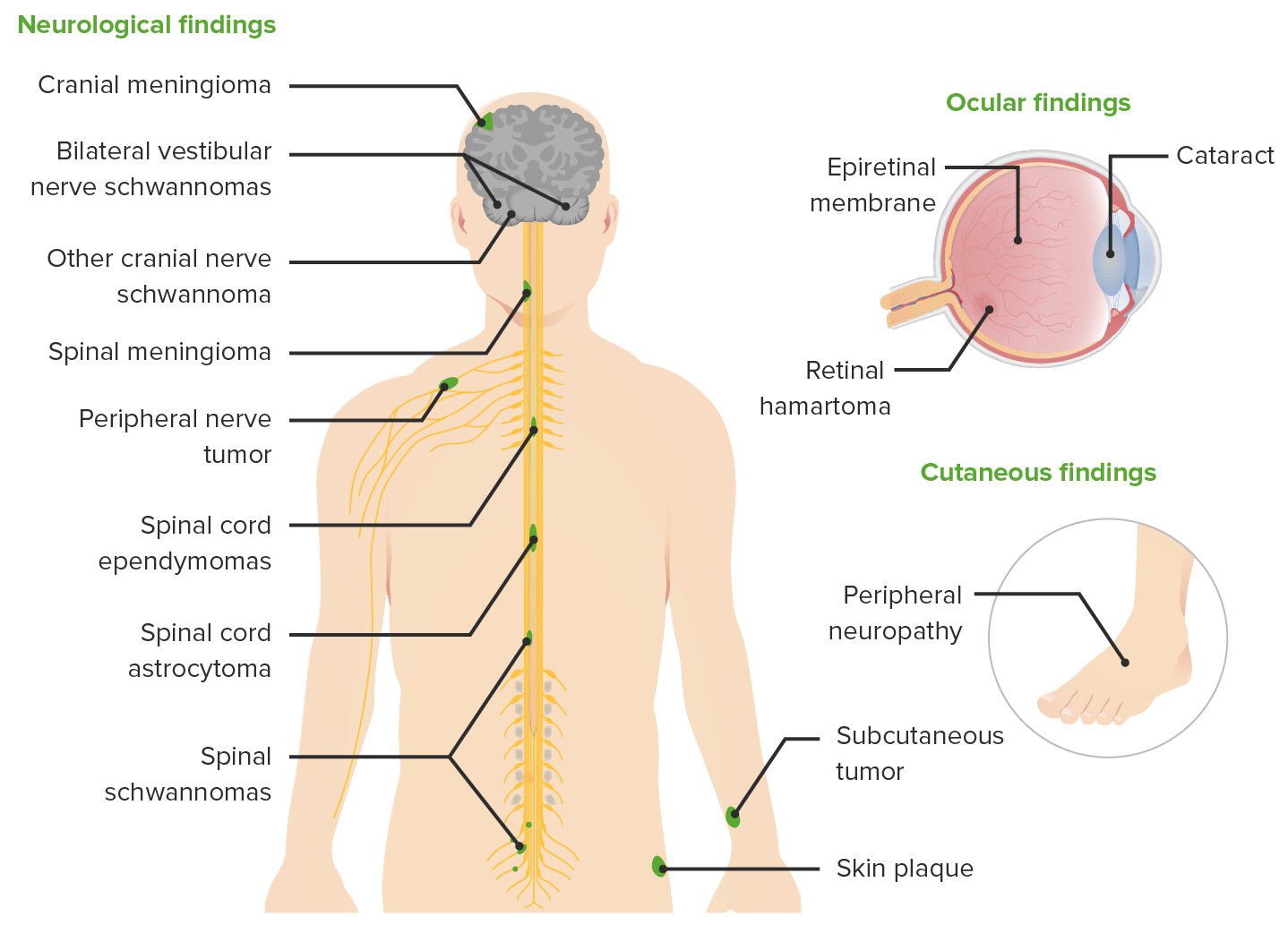Playlist
Show Playlist
Hide Playlist
Neurofibromatosis Type 2: Introduction
-
Strowd CNS Tumors Inherited Tumor Syndromes.pdf
-
Download Lecture Overview
00:00 So what is NF2? What used to be called central neurofibromatosis. 00:06 NF1 was peripheral neurofibromatosis, NF2 was central neurofibromatosis, because a lot of the manifestations are central. 00:15 Patients can have peripheral nervous system findings, and we'll talk about those. 00:19 So this is an old adage, but I think it's a helpful reminder of where we need to focus. 00:23 We'll need to do neuroimaging of the brain, and brainstem, and spinal cord, and we'll need to look for those central manifestations. 00:30 NF2 is not as common as NF1, but it can be more severe. 00:34 And so it's very important to have on a clinicians radar. 00:38 In contrast to NF1, which affects about one in 3000 individuals NF2 affects one in 50,000. 00:44 So you can see the degree of commonality and prevalence of this condition in comparison to NF1. 00:52 And it's characterized by schwannomas. 00:54 With NF1, the tumors we see are neurofibromas. 00:57 And with NF2, the tumors we see are schwannomas. 01:00 Different types of peripheral nerve sheath tumors. 01:04 And we can look at that histologically and see that schwannomas have these characteristic two regions, Antoni A and Antoni B regions, which we don't see in neurofibromas. 01:14 Not things I need you to note how to look at, but buzzwords that would be important on a test question or clinical vignette. 01:21 And here you can see in this patient a good example on this coronal T1 postcontrast image of a vestibular schwannoma. 01:27 Starting in the internal auditory canal, that canal that extends out into the ear and ear canal region, and then is bobbing into and compressing the brainstem. 01:40 NF2 results from a mutation in the NF2 gene, which is located on chromosome 22, which you can see depicted here. 01:48 NF2 results from a mutation in the NF2 gene. 01:51 And that gene encodes a protein, Merlin, or schwannomin. 01:55 And again, that's a tumor suppressor protein. 01:58 It puts two breaks or you need two breaks on tumor cell growth. 02:03 This is an autosomal dominant condition, but there can be mosaicism. 02:08 The vast majority of patients will acquire mutation in the NF2 gene, that is germline. 02:13 All cells in the body contain the NF2 mutation. 02:16 But sometimes the acquired mutation in the NF2 gene occurs after conception. 02:22 Downstream of the initial embryogenesis. 02:26 And this results in one part of the body or one location, that suffers from NF2 abnormality or an NF2 mutation, and that's called mosaicism. 02:35 Chromosome 22 is a neat chromosome. 02:37 There's a bunch of genes on that chromosome. 02:40 And I'd like for you to think of three of those genes, the LZTR1 gene, the SMARCB1 gene, and the NF2 gene. 02:49 Patients who have mutation in the NF2 gene will suffer from neurofibromatosis type2. 02:55 Additional mutation of SMARCB1 and LZTR1, it results in the development of schwannomatosis, which is similar and related but different from NF2. 03:06 So let's go back to that initial genetic slide and understand how Merlin and neurofibromin are related? Again, NF2 is a genetic condition. 03:16 It results from an abnormality in the NF2 gene, in the Merlin or schwannomin protein. 03:22 Loss of the NF2 gene results in loss of function of that Merlin protein. 03:27 Merlin is involved in a number of different things. 03:30 And while it's very clear what neurofibromin does in NF1 it's less clear how Merlin contributes to tumor cell growth. 03:37 But loss of Merlin is sufficient to drive tumor cell growth in characteristic areas of the nervous system.
About the Lecture
The lecture Neurofibromatosis Type 2: Introduction by Roy Strowd, MD is from the course CNS Tumors.
Included Quiz Questions
Which of the following is the histopathological characteristic of schwannomas?
- Antoni A and B regions
- Pseudopalisading pleomorphic cells
- Spindle cells arranged in a whorled pattern
- Chicken-wire capillary pattern
- Rosettes with small blue cells
The NF2 gene codes for which protein?
- Merlin
- GNAS1
- Menin
- Hamartin
- MEC
Customer reviews
5,0 of 5 stars
| 5 Stars |
|
5 |
| 4 Stars |
|
0 |
| 3 Stars |
|
0 |
| 2 Stars |
|
0 |
| 1 Star |
|
0 |




